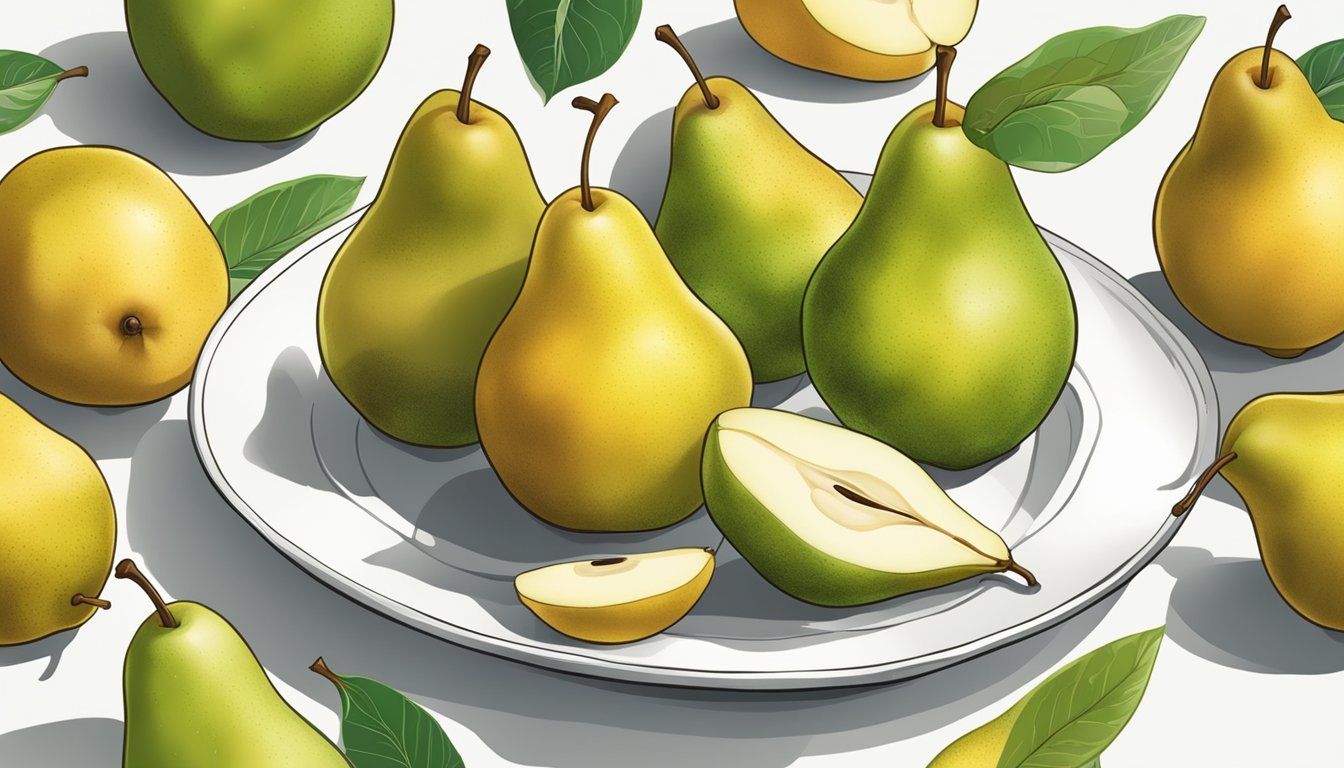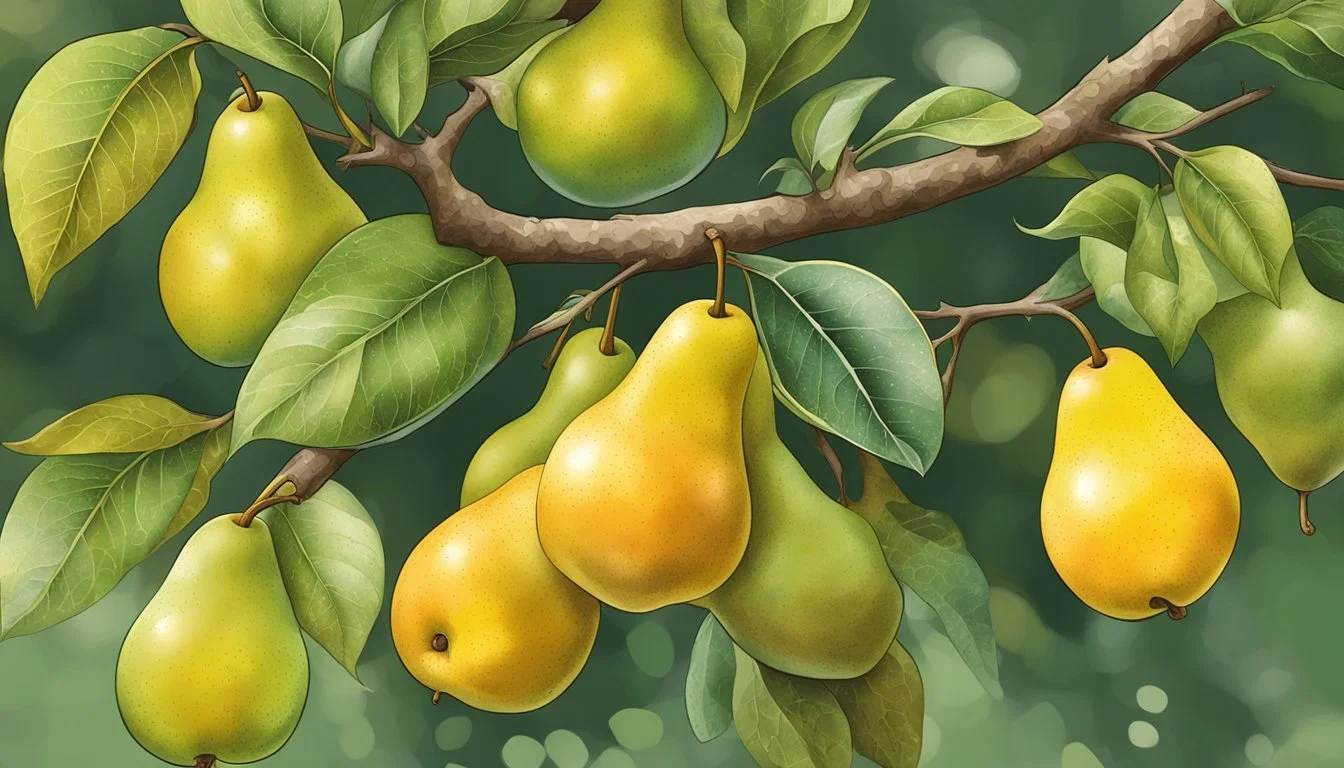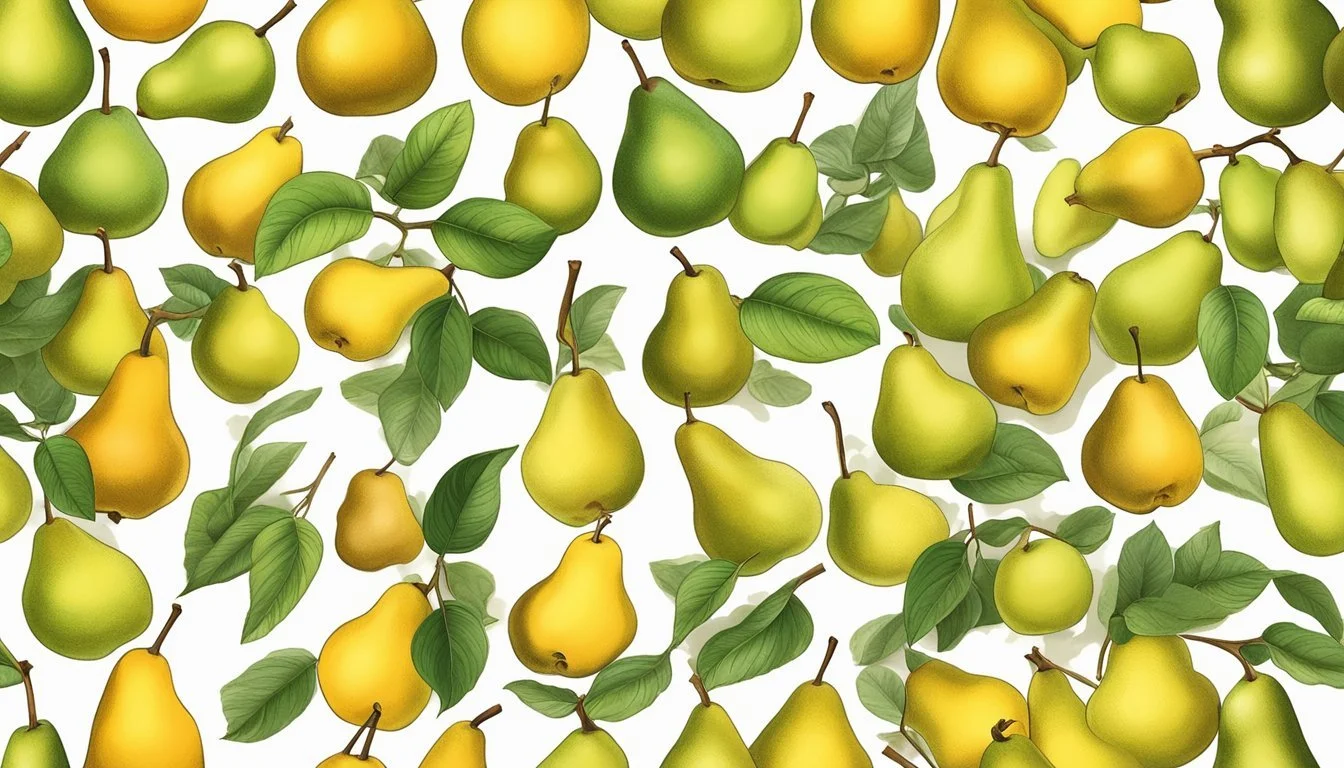How to Tell If Sierra Pears Are Ripe
Your Guide to Perfectly Juicy Fruit
Determining the perfect moment for enjoying a Sierra pear at the peak of its ripeness can be somewhat artful. Unlike other fruits that make it obvious when they're ready to be consumed, pears, and Sierra pears in particular, have subtler indicators of ripeness. The texture and firmness of a pear are critical cues, and the Sierra variety—known for its juicy, sweet flavor—demands careful attention to these details.
Since Sierra pears, much like their pear cousins, ripen from the inside out, traditional visual assessments aren't always reliable. A ripe Sierra pear won't necessarily betray its readiness through color alone. Instead, a simple, yet effective, method to check for ripeness is the feel around the neck or stem-end of the pear – this area tends to soften as the pear becomes ripe. Mastery of assessing pear ripeness is not only useful for immediate consumption but also plays a key role in storage, handling, and preserving the fruit for later use.
Key Takeaways
Pears show ripeness through subtle texture changes, especially near the stem.
Sierra pears require specific attention to textural cues as they ripen from the inside out.
Proper assessment of ripeness is essential for consumption, storage, and preservation.
Understanding Pear Ripeness
When assessing the ripeness of Sierra pears, one must consider the stages of ripening and specific varietal characteristics.
Stages of Pear Ripening
Sierra pears, like other pear varieties, undergo a distinct ripening process. Unlike some fruits that ripen uniformly, pears ripen from the inside out. Anjou, Bartlett, and Bosc pears typically mature while still on the tree but reach the ideal ripeness post-harvest. The ripening stages can be defined by firmness: a mature pear is firm but yields slightly to gentle pressure near the stem, indicating it has reached the consumption stage of ripeness.
Immature: The pear is too firm and lacks flavor.
Mature: The pear has developed full size and is ready to be picked.
Ripe: The pear is ideal for consumption; it's sweet and juicy.
Ripe pears can exude a fragrant aroma, a clear sign they are ready to be enjoyed. However, different pear varieties may not demonstrate this scent until they are overripe.
Varietal Characteristics
Each pear variety has unique characteristics that influence its ripeness cues. The Bartlett pear is known to change color as it ripens, turning from green to a golden hue. However, Bosc and Anjou pears require the pressure test at the neck to assess ripeness since their color remains relatively constant. Asian pears, differing from European varieties like Bartlett, Bosc, and Anjou, are firm even when ripe.
Variety: Bartlett
Ripeness Indicator: Color change to yellow, softness at the neck
Variety: Bosc
Ripeness Indicator: Slight give near the stem, no significant color change
Variety: Anjou
Ripeness Indicator: Yields to pressure at the neck, remains green
Variety: Asian Pears
Ripeness Indicator: Firm texture, slightly yield to pressure
Understanding these varietal differences is crucial for determining the optimal time to consume Sierra pears.
Signs of Ripeness
When determining the ripeness of Sierra pears, one must look for several specific indicators. These include changes in color and skin texture, the firmness of the fruit, and its aroma and flavor.
Visual Clues
Sierra pears exhibit subtle visual changes as they ripen. While they do not drastically change color like some other fruits, a ripe Sierra pear may have a slight yellowing, indicating it is ready to eat. One should look for an even and smooth skin texture. Discoloration or spots can imply an overripe or damaged pear.
Texture and Firmness
The texture and firmness of the pear are critical indicators of ripeness. A ripe pear will be slightly soft at the neck near the stem when gently pressed. However, if the entire fruit feels soft, it may be overripe. To the touch, the skin should yield slightly with firm pressure; if it is too firm, the pear is likely unripe and not yet flavorful.
Aroma and Flavor
A ripe Sierra pear will have a sweet and aromatic smell—unripe pears typically lack odor. The aroma should be pleasant and not overly intense, which could signal overripeness. When tasted, a ripe pear should be flavorful and juicy without any astringency, which is common in unripe pears. Overripe fruit, on the other hand, might taste overly sweet and have a mushy texture.
How to Ripen Pears
When Sierra pears are not quite ready to be enjoyed, one has options for ripening them at home. There are natural methods to ripen the pears as well as ways to speed up the process using ethylene gas.
Natural Ripening at Room Temperature
To ripen Sierra pears naturally, one should simply leave them at room temperature. Placing the pears on a countertop or in a fruit bowl allows them to ripen gradually. This method requires patience, as it can take several days for the pears to reach the desired level of ripeness. Room temperature is ideal, as temperatures that are too cold, such as those inside a refrigerator, can halt the ripening process, while overly warm conditions can cause premature decay.
Accelerating the Ripening with Ethylene
Ethylene gas is a natural plant hormone that encourages ripening. To speed up the ripening process of Sierra pears, one can use ethylene gas to their advantage.
Materials: Brown paper bag, ripe apples, avocados, or bananas.
Method: Place the pears inside the brown paper bag along with an apple, avocado, or banana—fruits that release high levels of ethylene.
Sealing: Roll the top of the bag to close it and create an environment rich in ethylene gas.
Observation: Check the pears daily to avoid over-ripening.
This method typically reduces the ripening time to a few days, depending on the initial ripeness of both the Sierra pears and the ethylene-producing fruit. Notably, while bananas are known ethylene producers, ripe apples and avocados also effectively generate the gas necessary for encouraging pears to soften and sweeten.
Proper Storage and Handling
Proper storage and handling are critical to maintaining the quality and extending the shelf life of Sierra pears. Strategies differ depending on whether pears are unripe or ripe, with the goal of optimizing the fruit's condition for consumption.
Storing Unripe Pears
Unripe Sierra pears should be stored at room temperature on a counter until they reach the desired ripeness. To delay the ripening process, one can store pears in a cool location away from direct sunlight. The ethylene gas produced naturally by pears as they ripen is a cue; thus, keeping them away from other ethylene-producing fruits can prevent premature ripening.
Preserving Ripe Pears
Once ripe, Sierra pears are best preserved by refrigeration. It is advisable to place them in the crisper drawer of a refrigerator to maintain a consistent temperature and humidity level. A plastic bag can be utilized to retain moisture, but it should be perforated to allow for some air circulation. Ripe pears can be refrigerated to significantly slow down further ripening and extend their freshness for later use.
By adhering to these storage guidelines, one can enjoy Sierra pears at their peak flavor and texture.
Using Ripe Pears
Once Sierra pears reach their peak ripeness, indicating a soft touch and a slight yield to pressure, they are ready for a multitude of uses, from fresh consumption to incorporation in various recipes. Handling them with care is crucial to preserve their vibrant color and delicate flesh.
Preparations for Immediate Use
To prepare a ripe Sierra pear for immediate consumption or use in a dish:
Perform the thumb test: Apply gentle pressure to the neck with your thumb. If the pear yields slightly, it's ready to use.
Check for bruises: Look for any soft spots or bruising. These areas can be cut away, as the rest of the pear is typically still good.
Wash the pear thoroughly, ensuring it’s clean and ready to be sliced or eaten whole.
Remove the stem and core if necessary, depending on how it will be used.
Ripe pears make for a healthy snack, and their sweet flavor pairs well with both sweet and savory dishes.
Culinary Applications
Sierra pears offer versatility in the kitchen:
Salads: Slice or dice ripe pears and add them to salads for a sweet element. Their vibrant color can make salads more appealing.
Baking: Incorporate pears into cakes, tarts, and pastries. When baking, pears should be firm enough to hold their shape, yet ripe enough for a sweet flavor.
Poaching: Ripe pears can be poached in wine or syrup, enhancing their natural sweetness.
Pear sauce: Similar to applesauce, a pear sauce can be created by cooking ripe pears until they are soft and then pureeing them.
Roasting: Combine ripe pears with vegetables for roasting to add a caramelized, sweet touch to savory dishes.
When cooking or baking with ripe Sierra pears, one can either peel the skin for a smoother texture or leave it on for added color and fiber. A bowl of ripe pears can also serve as an impressive table centerpiece due to their appealing look.
Ripe Pear Preservation Tips
Preserving the freshness of ripe Sierra pears ensures that one can enjoy their sweet, juicy flavor for as long as possible. Proper storage methods can extend the life of a ripe pear, while creative techniques allow for innovative uses beyond the fruit bowl.
Extending Shelf Life
To maintain the quality of ripe Sierra pears, one should refrigerate them as soon as they reach the preferred level of ripeness. Placing pears in the crisper drawer of the refrigerator can keep them fresh for a few more days. It's important to store them away from strong-smelling foods, as pears can absorb odors.
In Refrigerator: Store in the crisper drawer at a temperature between 35-40°F.
Separation: Store ripe pears separately from fruits like apples and plums that produce ethylene gas, which could speed up ripening.
By taking these steps, the shelf life of a ripe pear can be significantly extended, allowing more time for consumption at its peak quality.
Creative Preservation Methods
When a Sierra pear becomes overripe, one can adapt several creative preservation methods. Turning overripe fruit into jams or compotes is a delightful way to extend its usability, retaining the pear's essence in a versatile form. Dehydration is another option; dried pear slices make for a convenient and healthy snack.
Jam & Compotes: Cook down overripe pears with a bit of sugar and lemon juice.
Dehydration: Cut pears into thin slices and dry at a low temperature until they have a chewy texture.
Such preservation techniques not only prevent waste but also offer a spread of pear-derived products to enjoy year-round. These methods work well for Sierra pears purchased at the supermarket or harvested from one's own pear tree.
Pear Ripening FAQs
When it comes to Sierra pears, understanding the nuances of ripeness is key for both growers and consumers. This section addresses frequently asked questions, providing insights into the best practices for identifying ripe fruit and optimal harvest timing.
Common Questions from Growers
Optimal Harvest Time:
Growers often ask, when is the ideal time to pick Sierra pears? The optimal harvest time is typically when the fruit is mature but still firm. Sierra pears, much like other European pears, should be picked before they soften on the tree. The exact timing can vary based on local climate conditions but generally falls in late summer to early fall.Ripening Indicators:
It's crucial for growers to know how to tell if a Sierra pear is ripe on the tree. A mature Sierra pear exhibits subtle changes such as a slight softening at the stem end and a change in color to a more yellow or greenish-yellow hue. A faintly sweet aroma may also be a sign that the fruit is ready for harvest.
Consumer Inquiries on Ripeness
The Neck Test:
Consumers frequently question how to tell if a Sierra pear is ripe after purchase. They should perform the "neck test" by applying gentle pressure to the fruit's neck, near the stem. If the pear yields slightly, it indicates ripeness. This test is a reliable indicator for the consumer to assess if the pear is ready to eat.Storing for Ripeness:
Another common inquiry is how to ripen pears at home. Sierra pears ripen off the tree, so if they're firm at purchase, consumers can place them in a paper bag at room temperature to expedite ripening. Including an apple or banana in the bag can release more ethylene gas, which encourages ripening. It typically takes a few days for the fruit to soften enough to eat.
Conclusion
In identifying ripe Sierra pears, the neck test is a reliable method. Gently pressing near the stem end of the fruit should give a slight yield if the pear is ripe. However, it's crucial to avoid pressing too hard, as this could bruise the fruit.
A visual signal is less clear with Sierra pears, as they do not change color significantly. Their ripeness is more accurately gauged through touch and smell. A ripe Sierra pear emits a sweet, aromatic scent, and the absence of fragrance often indicates the fruit is not yet ripe.
For those wishing to expedite the ripening process of their Sierra pears, placing them in a paper bag with ethylene-producing fruits like bananas or apples can be effective. This method utilizes the natural gas these fruits emit to stimulate ripening in the pears.
As a consumer or a cultivator, understanding and applying these indicators empowers one to enjoy Sierra pears at the peak of their flavor and texture. It is these subtle nuances that distinguish a mere fruit eater from a fruit connoisseur. Remember, patience and attentiveness are key to enjoying perfectly ripened pears.




